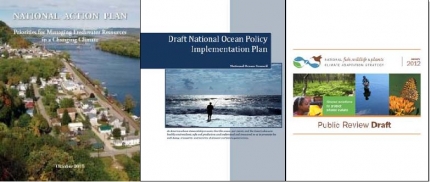Climate Change Adaptation Task Force
Task Force Progress Reports
On October 28, 2011 the Task Force released the 2011 Interagency Climate Change Adaptation Task Force Progress Report outlining the Federal Government's progress in expanding and strengthening the Nation's capacity to better understand, prepare for, and respond to extreme events and other climate change impacts. The report provides an update on actions in key areas of Federal adaptation, including: building resilience in local communities, safeguarding critical natural resources such as freshwater, and providing accessible climate information and tools to help decision-makers manage climate risks.
The 2011 Interagency Climate Change Adaptation Task Force Progress Report is available here.
On March 16, 2010, the Task Force released an Interim Progress Report, recommending key components to include in a national strategy on climate change adaptation. In October 2010, the Task Force articulated a set of policy goals and recommendations in a Progress Report to the President.
The 2010 Interagency Climate Change Adaptation Task Force Progress Report is available here.
Cross-cutting Strategies
The Interagency Climate Change Adaptation Task Force called in its October 2010 Progress Report for collaborative approaches within the government to address key cross-cutting issues related to climate change adaptation. The Task Force is working to ensure Federal Agencies align their climate change adaptation planning efforts to build a coordinated and comprehensive response to the impacts of climate change on public health, communities, oceans, wildlife, and water resources.
Key cross-cutting national strategies include:
-
Federal Agencies worked with stakeholders to develop a National Action Plan for managing freshwater resources in a changing climate in order to assure adequate water supplies and protect water quality, human health, property, and aquatic ecosystems, released in October of 2011.
- As part of President Obama's National Policy for the Stewardship of the Ocean, Our Coasts, and the Great Lakes, in January of 2012 the National Ocean Council released a draft National Ocean Policy Implementation Plan, which includes a series of actions to address the Resiliency and Adaptation to Climate Change and Ocean Acidification priority objective, one of nine priority objectives identified by the National Ocean Policy (NOP).
- Federal agencies are partnering with state, tribal and local representatives to develop a National Fish, Wildlife and Plants Climate Adaptation Strategy, for safeguarding our Nation’s species and natural resources. The draft Strategy was released in January of 2012.
More information on other adaptation efforts is available here.
Agency Climate Change Adaptation Planning
On October 5, 2009, President Obama signed Executive Order 13514, which set sustainability goals for Federal agency operations and directed agencies to improve their environmental, energy and economic performance. Under this Executive Order, each Federal agency is evaluating agency climate change risks and vulnerabilities to manage both the short- and long-term effects of climate change on the agency’s mission, programs, and operations.
On March 4, 2011, CEQ issued a set of Implementing Instructions for Federal Agency Adaptation Planning. The Instructions informed agencies on how to integrate climate change adaptation into their planning, operations, policies, and programs, as recommended by the Interagency Climate Change Adaptation Task Force in its October 2010 Progress Report to the President.
The Implementing Instructions are available here, along with the companion Support Document.
Agencies will include initial adaptation plans as part of the Strategic Sustainability Performance Plans they will submit to the Office of Management and Budget in 2012. Agency climate adaptation plans will be made publicly available through CEQ’s website once they are finalized and approved.
Adaptation Task Force Background
The Task Force's work has been guided by a strategic vision of a resilient, healthy, and prosperous Nation in the face of a changing climate. To achieve this vision, the Task Force identified a set of guiding principles that public and private decision-makers should consider in designing and implementing adaptation strategies. They include (but are not limited to) the following:
- Adopt Integrated Approaches: Adaptation should be incorporated into core policies, planning, practices, and programs whenever possible.
- Prioritize the Most Vulnerable: Adaptation strategies should help people, places, and infrastructure that are most vulnerable to climate impacts and be designed and implemented with meaningful involvement from all parts of society.
- Use Best-Available Science: Adaptation should be grounded in the best-available scientific understanding of climate change risks, impacts, and vulnerabilities.
- Apply Risk-Management Methods and Tools: Adaptation planning should incorporate risk-management methods and tools to help identify, assess, and prioritize options to reduce vulnerability to potential environmental, social, and economic implications of climate change.
- Apply Ecosystem-based Approaches: Adaptation should, where appropriate, take into account strategies to increase ecosystem resilience and protect critical ecosystem services on which humans depend, to reduce vulnerability of human and natural systems to climate change.








